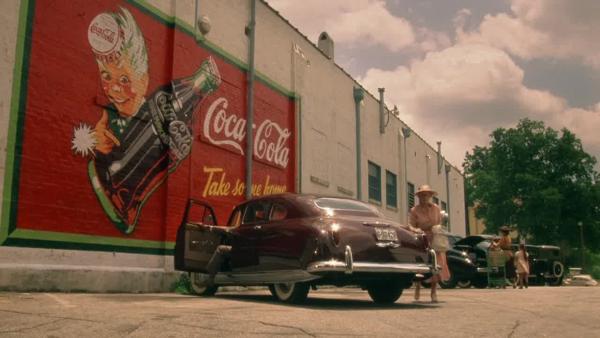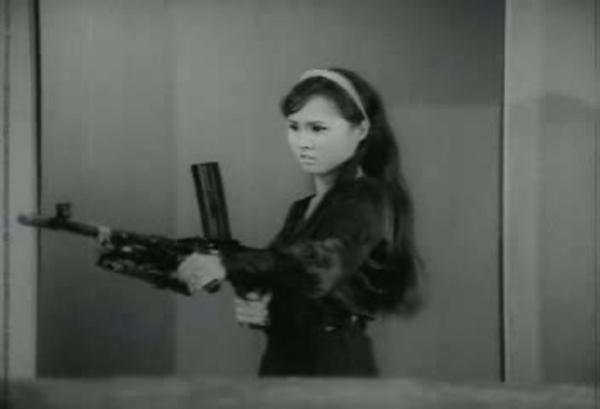Batman: The Dark Knight Returns, Part 2
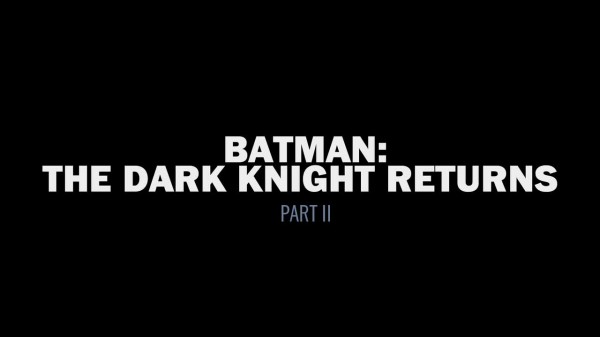
2013![]()
Based on the comic book by Frank Miller and Klaus Janson
Written by Bob Goodman
Characters created by Bob Kane, Bill Finger, Jerry Robinson, Jerry Siegel, Joe Shuster, and John Sikela
Directed by Jay Oliva
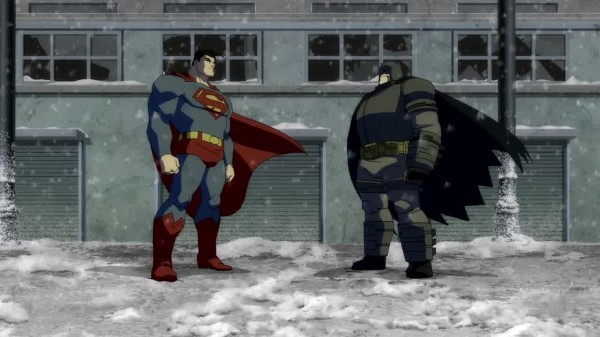
When last we left the Dark Knight, he had returned, and so had a lot of problems. Both an immediate threat and a looming menace have been defeated, and now things need mopping up. But new dangers lurk in the shadows, preparing to strike. And Batman’s activities have gained the attention of powerful people, who aren’t fans of things happening outside their control. The Dark Knight Returns continues with Part 2, covering issues #3 and 4 of the comic series. Fair warning, we pretty much go over every detail of the movie and comic, so SPOILERS!
The Joker has awakened from his catatonic state, for without the Batman around, there was no meaning in his life. Now he is infused with revitalized purpose, and the doctors at Arkham Asylum have taken a break from appearing on television to blame Batman for everything to praise Joker for the breakthroughs he’s accomplished. They feel the Joker has genuine remorse for his crimes. The manipulation here is more forced and too brief, in the comics Joker awakens earlier and we see him develop through a few scenes instead of jumping to the point. Though it does highlight the incompetent doctors by making them more incompetent. Joker is playing them like a fiddle, but he does manage to get them to agree to have him appear on a television show: The David Endocrine Show (a take on David Letterman, here voiced by excellent stunt casting with Conan O’Brien!) Batman immediately knows that Joker is planning to kill everyone. And he’s right.
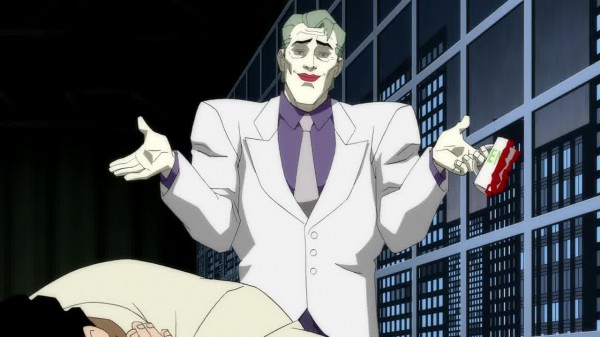
The Mutants have splintered in the wake of their leader’s defeat and humiliation. Some have taken up the mantle of Batman and viciously attack criminals in the streets. Others have formed more smaller gangs run by strongmen, or strongwomen, in the case of the Bruno gang. Bruno being a rather muscular woman who runs around without a shirt and only red paint Nazi swastikas covering her breasts. She’s referred to as Joker’s girl (this was pre-Harley Quinn), and she’s Batman’s next target as he tries to figure out what Joker is up to.
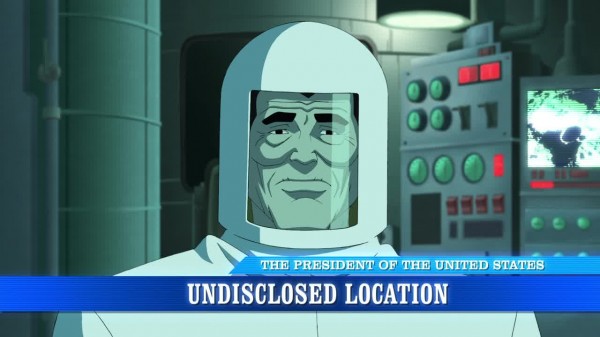
The cops are now lead by the new Commissioner Yindel, whose first act was to call for Batman’s arrest. They are guarding the roof of the studio with a massive force. The battle will be futile, the cops are well armed enough that despite all of Batman’s skills and tricks, there are just too many of them with too much force that he can’t get through. He’s saved by Carrie as she flies the Batcopter in close to pick him up. By then it is too late, everyone in the studio is dead and the Joker is free.
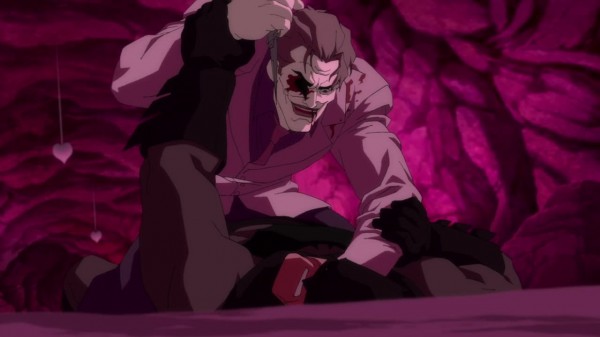
Over 200 died in the attack, and Joker is just getting started. He’s still laying clues for Batman to follow, as it’s all a big game. Joker moves from assaulting Selena Kyle (now of Kyle Escorts) to using one of the escorts to make a Congressman go deranged and suicide to an attack on the fair, with Batman in close pursuit (and Yindel in pursuit of Batman!) Batman has become increasingly violent in his attacks on criminals, and it becomes apparent Joker is going to get the same treatment. This also translates to Joker taking a batarang to the eye. Joker is like “Are you insane?” but goes with the flow, laughing all the while and gunning down everyone in his way.
The fight is the most brutal and gory of the series. Batman and Joker know it is the final fight, and there are pulling out all the stops. Batman has been shot and is stabbed multiple times, and their fight ends with Batman partially breaking Joker’s neck, leaving him paralyzed. Joker mocks his foe one last time, then finishes the job himself, snapping his neck the rest of the way. Joker knows Batman will be blamed, and claims victory for making Batman lose control. Batman is so injured that he has to rest by his enemy’s body, blacking out until the noise of the police pursuit awakens him. Only the help of Carrie in the Batcopter allows him to escape.
The final fight here just feels so right for a climatic battle between these two. Batman pushed to the edge, and the Joker getting a final laugh. I don’t think Joker expected to live through the fight. Had he killed Batman, he’d simply be back to the catatonic state he was in before. His goal must be to make sure they both die, to see their final battle costs everything. And he gets so very close to winning.
Tensions boil between the US and the USSR. Remember that Cold War tension of the 1980s? I grew up in that time, the land of constant threat of nuclear annihilation hanging over our heads. Of course, that threat is still around, it’s just ignored in favor of the current new boogeyman, terrorists! But back in the day, when commies were the greatest threat to the universe, the danger seemed real. Both The Dark Knight Returns and Watchmen exploit this fear for plot points.
The depiction of Reagan being relentlessly mocked is a breath of fresh air, thanks to constant attempts in recent years by conservative nutjobs to lionize Ronald Reagan as one of those “Great Men” we’ll be discussion below. If anything, Reagan was a Great Buffoon at best, and Great Monster at worst. Here, he’s leading the country into a war over a random scrap of country called Corto Maltese that has a parallel to the Cuban Missile Crisis. Except while that ended with things standing down, here tempers and arrogance flare, and Superman is sent in to fight the war. Reagan hides behind his tool of destruction, reassuring the public on television while relocating to a secret area and decked out in a radiation suit.

Later, Reagan’s reaction as a coldbringer missile EMPs the US and brings on a nuclear winter is more of a “Whoopsie! Those darn Soviets are sore losers!” The importance is the President, and by that, the system, isn’t going to stand by while he’s made to look bad by Batman. All the resources under his command, and he chooses to try to strike down someone else instead of work on rebuilding.
The running theme of The Dark Knight Returns is the relentless mocking of those in authority. From television guests to gutless mayors to angry presidents, everyone in power is depicted as incompetent and often vindictive. They aren’t the “Great Men” from the speech, they are pretenders to the throne who only serve to wreck the world more. Reagan risks nuclear annihilation in a war over some random country, let’s his army go without health care that results in a general selling military weapons on the black market, and conspires to tear down anyone doing it better than him, to keep from looking bad.
Batman is still injured from his battle with The Joker, but crises wait for no man, nor Batman. The city is without power due to the EMP, fires are spreading, no help is coming, and people are fighting for supplies. The Sons of Batman gang sees this as their time, their leader rallying the troops to go
With the fires, looters, general chaos, the only people that can stand against it aren’t those that are generally looked upon favorably. It’s the people who work outside the law that will have the most success. The gang members who saw the Mutant Leader as their hero, who splintered into groups following his defeat, searching for a new hero. The members who formed their own Sons of Batman gang. Those that were just wandering through the chaos looking for whatever.
The mob is undisciplined and armed, Batman immediately asserts his authority to disparage guns, implying that he will teach them how to use his weapons, but for tonight they will just follow his lead and use their fists. Their first act is to break up a looting riot between civilians and escaped Mutant gang members. Everyone fighting is tied up, but Batman gives a speech about how everyone needs to work together and use their community spirit to restore order, and anyone who wants to help is welcome. People are freed on both sides and join up. (Yes, there are a few who refuse to help, and are portrayed negatively, especially in the comic.)
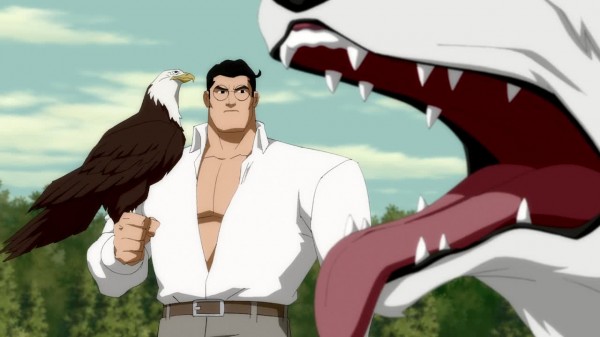
Seeing Batman on horseback leading the gangs to help stop the looting and panicking on the street, it turns Commissioner Yindel on to what Gordon was telling her about Great Men. She won’t order an attack on Batman, because he’s too big. Also, the city’s sort of falling apart and burning up, maybe your men should be helping with that instead of chasing costumed people?
Jim Gordon also works to organize fire brigades to help stop the fires. He’s not part of the gang lead by Batman, he’s organizing things on his own. He’s one of the common men who do the right thing, but because he’s spent decades working alongside the Great Man, he’s allowed to do a mini version of saving the city by saving a block or two.
A theme with the news interviews of the populace is how good people stood by and did nothing, but once someone started doing things, their paralysis was broken and they began to help out. Sure, there are a few examples of bitter people who refused to do anything, their own words damning how awful of people their are. The breaking of the paralysis mirrors the earlier news reports of show owners and others beginning to fight back against the rampant crime. The apathy washed aside by one of the Great Men. There were precursors to this with the populace starting to stand up to criminals, but now it’s a fountain of action by those inspired by Batman.
The originator of the Great Man Theory is generally recognized as Thomas Carlyle, who wrote in his 1841 book On Heroes, Hero-Worship, and the Heroic in History:
May we not say, moreover, while so many of our late Heroes have worked rather as revolutionary men, that nevertheless every Great Man, every genuine man, is by the nature of him a son of Order, not of Disorder? It is a tragical position for a true man to work in revolutions. He seems an anarchist; and indeed a painful element of anarchy does encumber him at every step,–him to whose whole soul anarchy is hostile, hateful. His mission is Order; every man’s is. He is here to make what was disorderly, chaotic, into a thing ruled, regular. He is the missionary of Order. Is not all work of man in this world a making of Order?
This certainly appears to apply to Batman. Batman is an agent of order, fighting against the chaos, while his nemesis Joker is pure anarchy. Batman is the Great Man like FDR was in Gordon’s speech from Part 1. Yindel sees him at work and instantly realizes what he is, that she’s powerless to do anything to oppose him. He’s too big.
I’m of the opinion the whole Great Men Theory is a bunch of bunk. History is far more complicated than things look in the history books, the “Great Men” require a massive amount of structural support done by unsung heroes of all genders, including many who may have done the bulk of the work the “Great Man” is credited for It’s a dishonor to the actual people by calling them Great Men, as it strips them of their humanity. Their flaws, their weaknesses, are just as much of a reality as their strengths. Go look at contemporary records and you’ll find plenty of criticism. Waiting around for a hero will just turn your hair grey as problems compound.
The Great Man theory became embraced by many who wrote history books, to the point where often history was simply the biographies of a few “Great Men” and everything else was left by the wayside. This got some great pushback from multiple sources, though my money is Howard Zinn’s A People’s History of the United States as the definitive rebuttal to the old history books. Zinn gave voices to the people who were there, not the Great Men, but the civilians, the native people, the soldiers, the servants. As a popular rebuttal to Great Man Theory (originally by Herbert Spencer) states, the Great Men are just products of the time and place in society, created by many hands and many lives. It’s the same argument against Objectivism, which is just Great Man Theory in a more selfish package.
I understand the attraction to these theories. Everyone likes to think they are awesome, and how they’d totally be successful if it wasn’t for all these jerks holding us back. Everyone likes getting praised for accomplishing things, without stopping to realize that it was sacrifices of others that helped make things possible. Your parents, friends, relatives, government subsidies/loans, teachers, medical researchers, food inspectors – you literally can’t do anything without having a support network that helped put you in the position to accomplish something. Yes, you do have to actually do the work to accomplish the goal, and there is nothing wrong with being proud of what you accomplished. The flaw is when you take all the credit, when you refuse to acknowledge the path that led you to where you stand. Batman would be dead without Carrie Kelley, without Alfred, without the other Robins, without Superman and the Justice League, without his family’s fortune, without Commissioner Gordon. Batman does a lot and accomplishes a lot. But he’s the product of a team, and he now leads a team to save Gotham from anarchy.
The implication is Batman’s stunts makes Gotham the safest place in America, every other city burns while order is restored. This becomes an embarrassment to the government, and Superman is ordered to go teach Batman a lesson.
Superman is first introduced before the nuclear action with orders to talk to Batman to try to keep him in line. It’s obviously not going to work, and Superman is uncomfortable pushing too far. Their meeting is a warning, Bruce knows who it’s really from, and doesn’t care. There is not too subtle imagery of an eagle perched on Superman’s arm looking magnificent, then flies out and sinks its talons in a wee mouse.
Superman goes to war, sent in by Reagan to lead the troops at Corto Maltese and ensure US interests are satisfied. From what we see, most of the winning is done solely by Superman, and the Russians launch a nuclear device at Corto Maltese in retaliation. Superman manages to stop it by bringing it off course, but the EMP shockwave knocks out all the power in the US and severely injures Superman. He crashes to Earth looking almost dead, so full of radiation the flowers and plants he touch wither and die. (This is also one of the coolest scenes in the comic!) Weeks later, he’s recovered enough to not look horrifying, but is still weakened.
Bruce knows their battle against Superman is inevitable, and when Reagan gives the orders, Batman picks the place and time. Which gives him time to prepare. Not just for the fight, but for everything. Remember: If Batman is prepared, he can’t lose.

Batman wears a powered armor suit, both to enhance his strength and defense, but also because it has a few gimmicks. He makes plans with Oliver Queen, aka Green Arrow, someone we know wouldn’t sit by and retire with the other heroes. Green Arrow is missing an arm, implied to be because of Superman, and has been fighting against the government while hiding underground (in the comic he sabotages the US’s nuclear retaliation against the Soviets.) Additionally, Oliver Queen became a leftist hero in his comics. Battling a despotic right wing government that’s willing to let it’s population burn and starve is right up his alley.
Batman has plans, traps, missiles, sonic weapons. When Batman plugs into the street lamp to electrocute Superman, he’s not just fighting himself, he’s fighting Superman with Gotham, with part of the city itself. The city that he helped save and is an embarrassment to the government. He’s not fighting to win, he’s fighting against the clock, because he has something else planned. The entire battle is just a diversion, but also a lesson. Superman is still weak and holding back against his friend. But as time ticks close to the edge, an arrow full of kryptonite means Superman is helpless and Batman has the upper hand. He gives the now famous speech about how he wants Superman to remember the one man who beat him, right before dropping dead of a heart attack.
For all his actions, Superman hears the trouble in his heart, tries to warn his friend. He’s never fully committed to bringing down Batman, because in a real fight Batman wouldn’t stand a chance. Superman could rip him to atoms before he even blinked. Batman’s greatest weapon is his friendship with his enemy. Or maybe Batman’s greatest ally in fighting Superman was Superman. Especially with Superman’s final act, his wink at the funeral. He knows what Bruce did, and he let’s it happen.
As far as sequels go, The Dark Knight Strikes Again reveals some things about the government and why the heroes retired, and why Superman (not so) willingly works for the government. It gets conspiratorial and works against some of the points made here. It was also written during 9-11, which not only influences the story, but also became a point where Frank Miller veered into crazy town. His subsequent work Holy Terror was rejected as a Batman story and was published as a standalone series. To call it racist would be an understatement. Miller joined the list of celebrities who became forever altered by 9-11 (another example is another Miller, Dennis Miller, who went from funny libertarian-leaning comic to unfunny right wing shill overnight).
Things have changed so much that Miller now advocates for the exact opposite of what The Dark Knight Returns seems to be saying. Here, the collection of gang members becomes Batman’s army to help restore order and hope for the people. They are all criminals, who would be in jail in any other circumstance. They’re also people without strong parental figures, who need a father figure to guide and look over them.
Frank Miller’s rant against the Occupy Wall Street movement, on the other hand, attacked the very people he redeemed as heroes:
“Occupy” is nothing but a pack of louts, thieves, and rapists, an unruly mob, fed by Woodstock-era nostalgia and putrid false righteousness. These clowns can do nothing but harm America.
Sure, the unruly mob is good enough for Batman, but not good enough for America. Ignoring that most Occupy protestors weren’t any of those things, the movement was a reaction by the 99% against the elite 1% in power. The very people Frank Miller spent this whole series relentlessly mocking. Now, he yells at the protestors and demands they join up in the military industrial system, get jobs that don’t exist, and basically shut up and go away. He also brings up terrorism for some reason, seemingly saying that whatever the government does to “protect” America is justified.
Had we not just seen the US start a war against commies, the old school boogeyman, just out of spite, and America suffered? This is a complete 180 turnaround, and embrace of the values that we just saw rejected. The reasons for this change I cannot definitely say. Is it due to his anti-Islamic bigotry? Or is it because the Occupy Movement is a leaderless revolt, and not a revolution led by a Great Man who Frank Miller can control by writing his words? Whatever problems there is with Occupy (and I do have some problems, despite agreeing with their general message), Miller isn’t arguing against them as much as he’s screaming into the night at shadows and demons.
I’m thankful that the general consensus seems to be that Frank Miller has lost it, but I’m also saddened. Saddened that someone could sink so far into the depths, and frustrated that I see this happen far too often and there is really nothing I can do about it. No matter how many words I write here, people who spiral into anger and fear aren’t going to suddenly click back into normalcy. The best defense against this is to talk to your family, talk to your friends, be a real person, help them through their issues and live the example of the life you want others to be. It doesn’t make you a “Great Man”, but it makes you a great person, someone who becomes a shining example through actions. You may have no idea how your actions influence others, but they will. Seeds will be planted, walls will slowly crumble. Change takes time, you can’t just vote once every four years and expect things to be better. There will be troubled water along the journey, but live the good life where you fight for what’s right.
Batman: The Dark Knight Returns translates amazingly well to cartoon form. The major loss is the narration, much of which does make it into the film in the form of conversations. A few things are altered, but nothing major is missed. The voice acting is spot on perfect. Frank Weller as the older Batman/Bruce Wayne with the booming but perfectly aged voice of power. Ariel Winter turning Carrie Kelley’s teenage slang and swagger into a fully realized character searching for meaning for her life. David Selby, Michael Emerson, and Mark Valley fit snugly into their roles as well. This isn’t a series that would work with the classic DC Animated voice casts. It needs to live on its separate plane. The bit players are filled with voices anyone whose watched a batch of 80s, 90s, and 00s cartoons will recognize, and yet the don’t feel out of place. I also love the soundtrack. These might eclipse Justice League: Crisis on Two Earths as my favorite DC Animated film. I highly recommend you give them a chance, even if you disagree with whatever nonsense Frank Miller is spilling this week. These are great stories, hitting the notes to be entertaining while still giving a great dose of Batman essence that has stuck with the character to this day.

Rated 9/10 (friend, robot, news graphics, butler, helper, band leader, host with the most, burning in hell, King of Queens)
Please give feedback below!
Email us and tell us how much we suck!
Citations:
On Heroes, Hero-Worship, and the Heroic in History by Thomas Carlyle
The Very Political Frank Miller: From “The Dark Knight Returns” To “Anarchy” by Colin Smith
Frank Miller’s ANARCHY blog post
How Ayn Rand Seduced Generations of Young Men and Helped Make the U.S. Into a Selfish, Greedy Nation by Bruce E. Levine

















